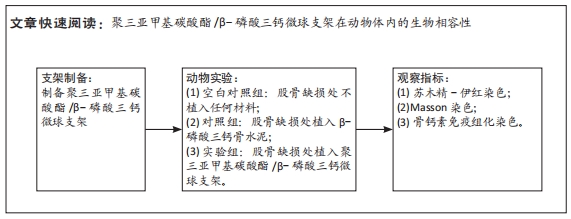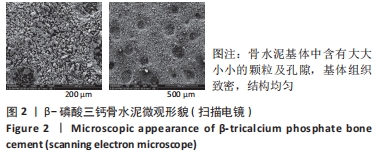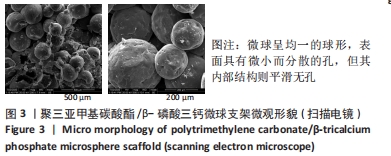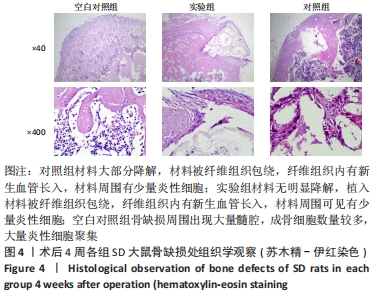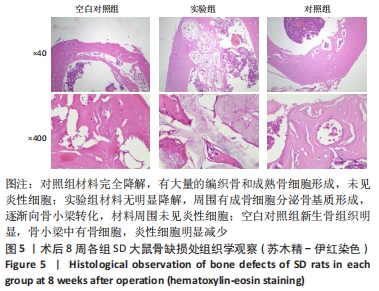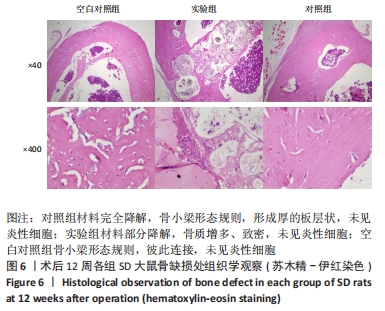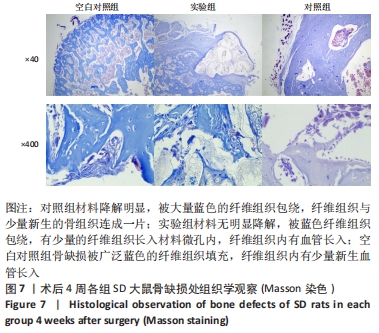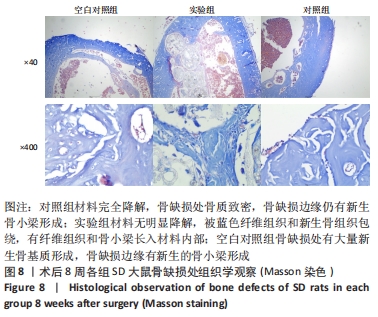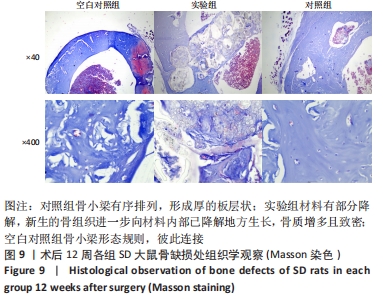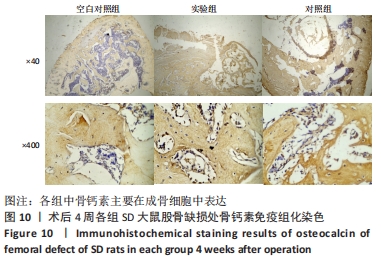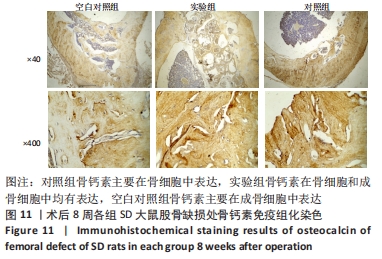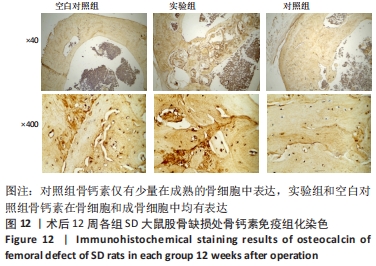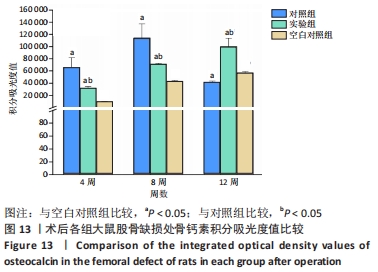[1] 刘洋.骨组织工程支架材料研究进展[J].临床口腔医学杂志,2019, 35(10):637-639.
[2] 倪建光,刘丹平.骨组织工程支架材料的研究进展[J].中国组织工程研究,2009,13(8):1525-1528.
[3] WANG W, YEUNG KWK. Bone grafts and biomaterials substitutes for bone defect repair: A review. Bioact Mater. 2017;2(4):224-247.
[4] CAMPANA V, MILANO G, PAGANO E, et al. Bone substitutes in orthopaedic surgery: from basic science to clinical practice. J Mater Sci Mater Med. 2014;25(10):2445-2461.
[5] BUROVA I, WALL I, SHIPLEY RJ. Mathematical and computational models for bone tissue engineering in bioreactor systems. J Tissue Eng. 2019;10:204173141982792.
[6] BI L, CHENG W, FAN H, et al. Reconstruction of Goat Tibial Defects Using an Injectable Tricalcium Phosphate/Chitosan in Combination with Autologous Platelet-Rich Plasma. Biomaterials 2010;31(12):3201-3211.
[7] BAL Z, KAITO T, KORKUSUZ F, et al. Bone regeneration with hydroxyapatite-based biomaterials. Emergent Mater. 2020;3(4):521-544.
[8] REZWAN K, CHEN QZ, BLAKER JJ, et al. Biodegradable and Bioactive Porous Polymer/Inorganic Composite Scaffolds for Bone Tissue Engineering. Biomaterials. 2006;27(18):3413-3431.
[9] REN J, BLACKWOOD KA, DOUSTGANI A, et al. Melt-electrospun polycaprolactone strontium substituted bioactive glass scaffolds for bone regeneration. J Biomed Mater Res A. 2014;102(9):3140-3153.
[10] LI J, JIN L, WANG M, et al. Repair of rat cranial bone defect by using bone morphogenetic protein-2-related peptide combined with microspheres composed of polylactic acid/polyglycolic acid copolymer and chitosan. Biomed Mater. 2015;10(4):045004.
[11] FUKUSHIMA K. Poly(trimethylene carbonate)-based polymers engineered for biodegradable functional biomaterials. Biomater Sci. 2016;4(1):9-24.
[12] LIU H, SLAMOVICH EB, WEBSTER TJ. Increased osteoblast functions among nanophase titania/poly(lactide-co-glycolide) composites of the highest nanometer surface roughness. J Biomed Mater Res A. 2006; 78(4):798-807.
[13] FIRDAUS SM, SHENG TJ, ARIFFIN Z, et al. Properties improvement of acrylic resin for denture application: effect of single and hybrid types of fillers with different weight loadings. Plast Rubber Compos. 2021;(1): 1-11.
[14] PÊGO AP, VAN LUYN MJ, BROUWER LA, et al. In vivo behavior of poly(1,3-trimethylene carbonate) and copolymers of 1,3-trimethylene carbonate with D,L-lactide or Ɛ-caprolactone: Degradation and tissue response. J Biomed Mater Res A. 2003;67(3):1044-1054.
[15] RONGEN JJ, VAN BOCHOVE B, HANNINK G, et al. Degradation behavior of, and tissue response to photo-crosslinked poly(trimethylene carbonate) networks. J Biomed Mater Res A. 2016;104(11):2823-2832.
[16] PÊGO AP, VLEGGEERT-LANKAMP CL, DEENEN M, et al. Adhesion and growth of humanSchwann cells on trimethylene carbonate (co)polymers. J BiomedMater Res A. 2003;67:876-885.
[17] ZENG N, LEEUWEN A, YUAN H, et al. Evaluation of novel resorbable membranes for bone augmentation in a rat model. Clin Oral Implants Res. 2016;27(2):8-14.
[18] HE J, ZHANG Y, LIU X, et al. Load-bearing PTMC-beta tri-calcium phosphate and dexamethasone biphasic composite microsphere scaffolds for bone tissue engineering. Mater Lett. 2019; 260:126939.
[19] 陈江,陈旭晞,周麟.骨免疫调节机制对种植体骨结合及骨生物材料引导骨再生的影响[J].广东牙病防治,2018,26(10):613-620.
[20] CHAN JK, GLASS GE, ERSEK A, et al. Low-dose TNF augments fracture healing in normal and osteoporotic bone by up-regulating the innate immune response. EMBO Mol Med. 2015;7(5):547-561.
[21] 罗伟,李翔翮,杨先腾,等.骨折模型小鼠周围组织E、P选择素含量变化及意义[J].中国组织工程研究,2019,23(3):82-86.
[22] KIM J, HEMATTI P. Mesenchymal stem cell-educated macrophages: A novel type of alternatively activated macrophages. Exp Hematol. 2009;37(12):1445-1453.
[23] BORCHERS A, TEUBER SS, KEEN CL, et al. Clinical Reviews in Allergy and Immunology. Clin Rev Allergy Immunol. 2010;39(2):95-141.
[24] KEILIS-BOROK IV, RAEVSKAYA MV, FRIDENSHTEIN AY, et al. Properties of bone tissue induced by transitional epithelium. Biull Eksp Biol Med. 1982;94(12):87-89.
[25] LIU H, CAI Q, LIAN P, et al. β-tricalcium phosphate nanoparticles adhered carbon nanofibrous membrane for human osteoblasts cell culture. Mater Lett. 2010;64(6):725-728.
[26] GHAYOR C, BHATTACHARYA I, WEBER FE. The optimal microarchitecture of 3D-printed β-TCP bone substitutes for vertical bone augmentation differs from that for osteoconduction. Mater Design. 2021;204(6): 109650.
[27] YUAN H. Bone formation induced by calcium phosphate ceramics in soft tissue of dogs: a comparative study between porous α-TCP and β-TCP. J Mater Sci Mater Med.2001;12(1):7-13.
[28] TAYEBI M, PARHAM S, AHANGAR HA, et al. Preparation and evaluation of bioactive bilayer composite membrane PHB/β‐TCP with ciprofloxacin and vitamin D3 delivery for regenerative damaged tissue in periodontal disease. J Appl Polym Sci. 2021;139(3):e51507.
[29] 刘兆强,朱立国.磷酸钙材料在骨再生中的应用进展[J].中国医疗设备,2019,34(10):158-163.
[30] BEREZOVSKA O, YILDIRIM G, BUDELL WC, et al. Osteocalcin affects bone mineral and mechanical properties in female mice. Bone. 2019; 128:115031.
[31] AL-RIFAI O, CHOW J, LACOMBE J, et al. Proprotein convertase furin regulates osteocalcin and bone endocrine function. J ClinInvest. 2017; 127(11):4104-4117.
[32] HAUSCHKA PV, LIAN JB, GALLOP PM. Direct identification of the calcium-binding amino acid, gamma-carboxyglutamate, in mineralized tissue. Proc Natl Acad Sci U S A. 1975;72(10):3925-3929.
[33] PRICE PA, OTSUKA AA, POSER JW, et al. Characterization of a gamma-carboxyglutamic acid-containing protein from bone. Proc Natl Acad Sci U S A. 1976;73(5):1447-1451.
[34] HAN X, DU J, DI L, et al. Histochemical examination of systemic administration of eldecalcitol combined with guided bone regeneration for bone defect restoration in rats. J Mol Histol. 2016;48(1):1-11.
[35] HE J, HU X, ZHANG Y, et al. A composite polytrimethylene carbonate microsphere-reinforced porous scaffold for osteoblast regeneration. Colloids Surf A Physicochem Eng Asp. 2019;587:124325
|
